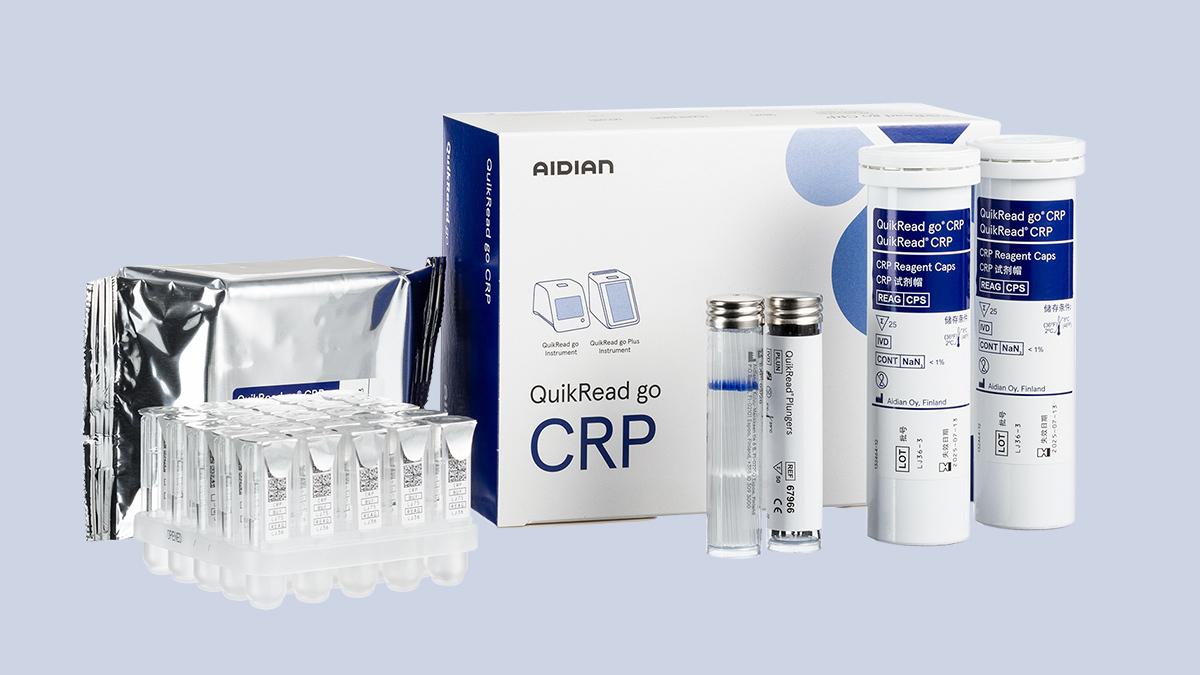QuikRead go CRP
QuikRead go CRP is a fast and simple rapid test for the quantitative determination of C-reactive protein (CRP) in whole blood, serum, and plasma with QuikRead go instrument. The test gives reliable results within minutes and speeds up the path for correct diagnosis.

Generally
Versatile point of care CRP testing with QuikRead go CRP
Accurate C-reactive protein (CRP) measurement is essential in managing patients with symptoms of infection and inflammation. A fast CRP test helps to identify patients who benefit from antibiotic treatment, and it is valuable in monitoring treatment response1. It can also be used for evaluation and monitoring of inflammatory conditions2. The easy-to-use QuikRead go CRP test can be used near the patient, providing immediate CRP results.

CRP point of care testing supports evidence-based treatment decisions for bacterial infections. Antibiotics should not be used for viral infections, and diagnostic confirmation of bacterial infections decreases unnecessary antibiotic use. QuikRead go CRP is an efficient tool for point of care settings, guiding the treatment decisions of healthcare professionals.
Simple sample collection
- No manual steps
- Wide automatic haematocrit correction
- Finger prick or venous whole blood sample. Plasma or serum can also be used
Reliable results within minutes
- Analysis time 2 minutes
- CRP measuring range 5 – 200 mg/l*
- Results are comparable to laboratory tests
Effortless testing with the QuikRead go multianalyte instrument
- Ready-to-use reagents
- Fully automated measurement
- Maintenance free
- Battery use ensures full portability
- Bi-directional connectivity to most HIS and LIS systems
*with whole blood and haematocrit of 40%, with plasma and serum 5 – 120 mg/l
Test results should never be used alone, without a complete clinical evaluation.
This version of QuikRead go CRP is not registered in the USA (link to the US product version: QuikRead go CRP for the USA).
References
- Van Hecke O et al. Guidance on C-reactive protein point-of-care testing and complementary strategies to improve antibiotic prescribing for adults with lower respiratory tract infections in primary care. Front. Med. 2023; 10: 1166742.
- Markanday A et al. Acute phase reactants in infections: Evidence-based review and a guide for clinicians. Open Forum Infect Dis. 2015; 2:ofv098.
Technical data
| Products available |
|
| Use | For in vitro diagnostic use, IVD CE |
| Method | Immunoturbidimetric |
| Sample type | Whole blood, serum, plasma |
| Instrument information | QuikRead go system instruments |
| Measurement time | 2 minutes |
| Reading of the result | Instrument read |
| Storage | 2 - 8 °C |
| Size and weight | 190 x 140 x 80 mm / 0.500 kg |
| Additionally needed |
|
| Country of origin | Finland |
| Registration | This version of the QuikRead go CRP is not registered in the USA |
| Registered trademark | QuikRead go is a registered trademark of Aidian Oy |
About C-reactive protein (CRP)
CRP aids clinical management of patients with infections or inflammatory conditions.
Learn more: About C-reactive protein
Antimicrobial resistance and CRP
Antimicrobial resistance is a global health threat. CRP point of care testing aids management of respiratory infections and fighting against antimicrobial resistance.
Learn more: Antimicrobial resistance and CRP
Documents and materials
Marketing and sales materials
QuikRead go CRP Brief Instructions (EN)
CRP Control Procedure Brief Instructions (EN)
QuikRead go Plus Family Brochure (EN)
QuikRead go Family Brochure (EN)
QuikRead go Plus Technical Specifications (EN)
QuikRead go Technical Specifications (EN)
Instructions for Fingertip Blood Collection (EN)
QuikRead go Control Information (EN)
QuikRead go workstation Flyer (EN)
The Benefits of CRP Point-of-Care Testing in General Practice (EN)
Instructions for use
(For informative use only. Kindly always refer to the latest package insert in the kit.)
QuikRead go CRP IFU (GB, DE, FR, IT), 135171
QuikRead go CRP IFU (FI, SE, ES, NL), 135171
QuikRead go CRP IFU (SI, RS, HR, GR), 135171
QuikRead go CRP IFU (CZ, SK, HU, PL), 135171
Safety Data Sheet
If you wish to receive a Safety data sheet, please contact: product.support@aidian.eu
Videos
-
Test videos using QuikRead go Instrument
-
Test videos using QuikRead go Plus Instrument
Frequently asked questions
Is it possible to use QuikRead CRP kits for QuikRead go?
No, for QuikRead go you can only use QuikRead go CRP kits. QuikRead go requires a bar code on the cuvette, whereas QuikRead 101 uses a magnetic card.
The QuikRead go instrument gives me a result of > 200 mg/l, but I would like to get an exact CRP result. Is it possible?
When using plasma/serum samples you can dilute the sample with 0.9 % NaCl before adding it to the cuvette. The recommended dilution is 1+3. Remember to multiply the result by 4.
I accidentally left a QuikRead go CRP kit at room temperature for a weekend. Can I still use it?
Yes, you can use the kit. The kit can be stored at room temperature (18 - 25 °C) for one month. If it is used at room temperature during daily working hours (7.5 hours) and stored at 2 - 8 °C after finishing work, the kit will remain stable for 3 months.
Can I use controls other than QuikRead CRP Controls with the QuikRead go CRP kit?
Yes, you can use other commercially available controls. The acceptable control limits must be defined with the precision results gained with the QuikRead go instrument. The blanking process might not succeed if you use a control which contains artificial red blood cells because they might not haemolyse normally.
Why do QuikRead go CRP kit components have different expiration dates and why does the kit have shorter shelf life than some of the components?
The kit components have different chemical properties. Therefore, the shelf lives of the components are different. The kit has it’s own expiration date which is the same as the expiration date of the first expiring component.


